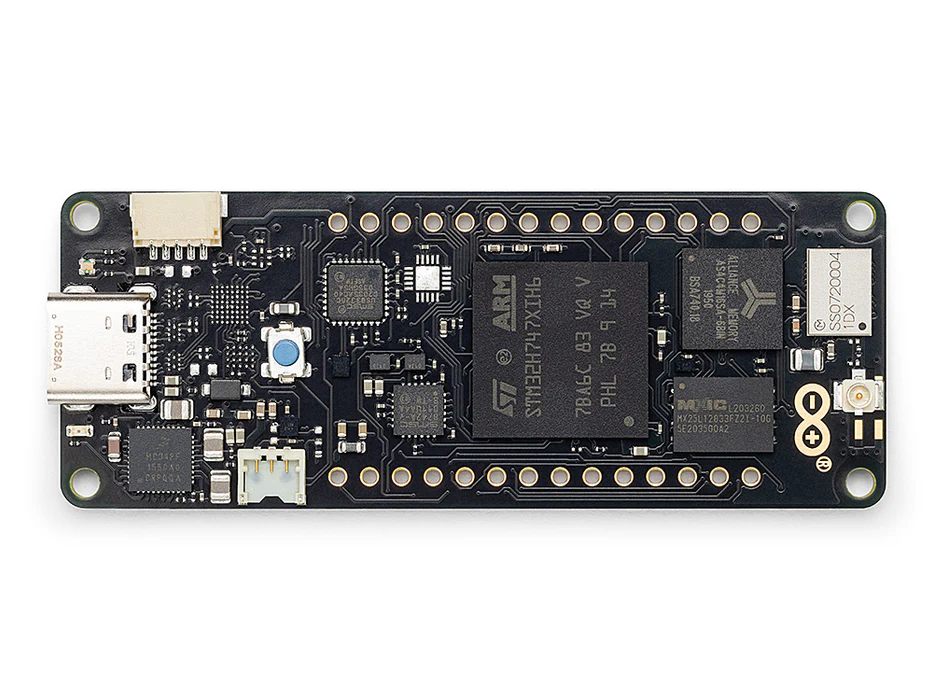
Overview
The Portenta H7 Lite Connected is designed to provide the computational power of the Portenta H7 for AI applications and low-latency control solutions, with a module that is made more cost-effective by removing the high-resolution video interface feature.
It fills the gap between the full H7 and the H7 Lite versions by integrating wireless connectivity, adding yet another option for Arduino Pro clients to build the perfect solution with the right combination of performance and simplicity.
The Portenta H7 Lite Connected simultaneously runs high-level code and real-time tasks thanks to its two processors. For example, it can execute Arduino-compiled and MicroPython code at the same time, and have the two cores communicate via a Remote Procedure Call mechanism that allows calling functions on the other processor seamlessly for real multitasking. Your machine learning algorithms can now run simultaneously alongside low latency sensor/actuator interaction.
Key benefits include:
- Dual Core - Two best-in-class processors in one, running parallel tasks
- AI on the edge - So powerful it can run AI state machines
- Onboard wireless module - Simultaneously manage WiFi and Bluetooth® connectivity
- High-level programming language support (Micropython)
- Security - Onboard secure element for certificates storage and management
The Portenta H7 Lite Connected offers twofold functionality: it can run either like any other embedded microcontroller board, or as the main processor of an embedded computer.
For example, use the Portenta Vision Shield to transform your H7 Lite Connected into an industrial camera capable of performing real-time machine learning algorithms on live video feeds. As the H7 Lite Connected can easily run processes created with TensorFlow™ Lite, you could have one of the cores computing a computer vision algorithm on the fly, while the other carries out low-level operations like controlling a motor or acting as a user interface.
Portenta is the go-to family when performance is key, and the H7 Lite Connected is no exception. We can already envision it as part of a wide range of solutions, including:
- High-end industrial machinery
- Laboratory equipment
- Computer vision
- PLCs
- Robotics controllers
- Mission-critical devices
- High-speed booting computation (ms)
Two Parallel Cores
The Portenta H7 Lite Connected’s main processor is the STM32H747 dual core including a Cortex® M7 running at 480 MHz and a Cortex® M4 running at 240 MHz. The two cores communicate via a Remote Procedure Call mechanism that allows calling functions on the other processor seamlessly. Both processors share all the in-chip peripherals and can run:
- Arduino sketches on top of the Arm® Mbed™ OS
- Native Mbed™ applications
- MicroPython / JavaScript via an interpreter
- TensorFlow™ Lite
A New Standard for Pinouts
The Portenta family adds two 80-pin high-density connectors at the bottom of the module. This ensures scalability for a wide range of applications: simply upgrade your Portenta to the one suiting your needs.
USB-C® Multipurpose Connector
The module’s programming connector is a USB-C port that can also be used for power, as a USB Hub, or to deliver power to OTG connected devices.
Arduino IoT Cloud Compatible
Use your MKR board on Arduino's IoT Cloud, a simple and fast way to ensure secure communication for all of your connected Things.
TRY THE ARDUINO IOT CLOUD FOR FREE
Need Help?
Check the Arduino Forum for questions about the Arduino Language, or how to make your own Projects with Arduino. If you need any help, please get in touch with the official Arduino User Support as explained in our Contact Us page.
Warranty
You can find your warranty information here.
Tech specs
|
Microcontroller |
STM32H747XI dual Cortex®-M7+M4 32bit low power Arm® MCU (datasheet) |
|
CONNECTIVITY |
Ethernet, WiFi, Bluetooth® Low Energy |
|
Secure Element (default) |
Microchip ATECC608 |
|
Power Supply (USB/VIN) |
5V |
|
Supported Battery |
Li-Po Single Cell, 3.7V, 700mAh Minimum (integrated charger) |
|
Circuit Operating Voltage |
3.3V |
|
Current Consumption |
2.95 μA in Standby mode (Backup SRAM OFF, RTC/LSE ON) |
|
Timers |
22x timers and watchdogs |
|
UART |
4x ports (2 with flow control) |
|
Ethernet PHY |
10 / 100 Mbps (through expansion port only) |
|
SD Card |
Interface for SD Card connector (through expansion port only) |
|
Operational Temperature |
-40 °C to +85 °C |
|
MKR Headers |
Use any of the existing industrial MKR shields on it |
|
High-density Connectors |
Two 80 pin connectors will expose all of the module's peripherals to other devices |
|
Camera Interface |
8-bit, up to 80 MHz |
|
ADC |
3× ADCs with 16-bit max. resolution (up to 36 channels, up to 3.6 MSPS) |
|
DAC |
2× 12-bit DAC (1 MHz) available, only one is accessible by the user through the external A6 pin |
|
USB-C |
Host / Device, High / Full Speed, Power delivery |
Conformities
Resources for Safety and Products
Manufacturer Information
The production information includes the address and related details of the product manufacturer.
Arduino S.r.l.
Via Andrea Appiani, 25
Monza, MB, IT, 20900
https://www.arduino.cc/
Responsible Person in the EU
An EU-based economic operator who ensures the product's compliance with the required regulations.
Arduino S.r.l.
Via Andrea Appiani, 25
Monza, MB, IT, 20900
Phone: +39 0113157477
Email: support@arduino.cc
Documentation
Learn more
Get Inspired

In a world where energy bills are climbing and the environment is on our minds, keeping tabs on how we use energy at home has become a smart move. Every gadget we plug in impacts our wallets and the planet. That's where home energy monitoring comes in – giving us real-time info on how we're using energy, so we can save money and do our bit for the Earth. This post delves into home energy monitoring, spotlighting how to track your energy consumption using the Arduino Cloud and a Tuya-compatible energy meter with Node-RED acting as a middleware. What's the deal with home energy monitoring? Home energy monitoring is all about watching how much energy we're using at home. It's not just about paying the bills; it's about knowing what's eating up energy, so we can be smarter about it. Why does it matter? Well, first off, it helps us be more aware. When we can see which devices are energy hogs (looking at you, always-on TV), we can take action. And with energy costs going up, finding ways to save money is a no-brainer. Plus, with everyone talking about being green these days, knowing where your energy goes is like a badge of honor for doing your part. The ingredients The key component in this setup is an energy meter designed to monitor both real-time and cumulative power consumption, along with metrics such as voltage and current. This meter is installed within your home's electrical distribution board. Tuya-compatible devices have gained widespread popularity due to their affordability, user-friendliness, and seamless management through the SmartLife application. Moreover, these devices can also be seamlessly integrated into alternative platforms through the utilization of the Tuya API. The Arduino Cloud stands out as a versatile and user-friendly IoT platform, supporting a wide range of hardware. It's not only customizable and adaptable to suit different purposes and use cases, but it also streamlines the incorporation of multiple devices,











